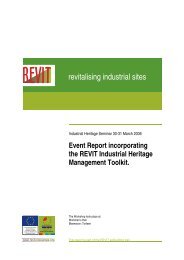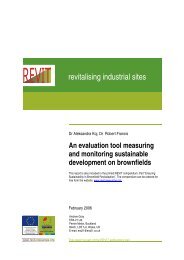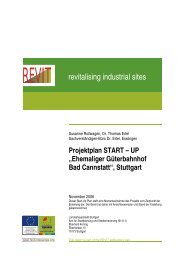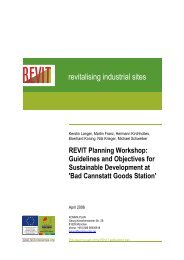STAKEHOLDER ENGAGEMENT - A TOOLKIT - REVIT
STAKEHOLDER ENGAGEMENT - A TOOLKIT - REVIT
STAKEHOLDER ENGAGEMENT - A TOOLKIT - REVIT
You also want an ePaper? Increase the reach of your titles
YUMPU automatically turns print PDFs into web optimized ePapers that Google loves.
Other Key Issues to consider when identifying potential Stakeholder<br />
Groups<br />
• Who decides who is involved. As the selection of participants can be<br />
such a politically charged responsibility, it is useful to make the selection<br />
process as transparent as possible. Ideally, the planning/design group for<br />
the whole process will make these decisions. It is wise to ensure that the<br />
reasons for selection are noted so that any questions about selection can<br />
be answered.<br />
• Resisting pressure on numbers. There is often internal and external<br />
pressure to expand or reduce the list of those involved. The number<br />
of people involved should not be arbitrary but based on a coherent<br />
understanding of the purpose and the context of the process.<br />
• Marginalising “Usual suspects”. Organisations sometimes try to avoid<br />
involving the “usual suspects”, which has become a term of denigration<br />
for people who habitually give time and effort to what they see as their<br />
civic responsibilities. Describing someone as a ‘usual suspect’ should<br />
never be grounds to exclude them from a process any more than it is<br />
grounds for including them: people should be involved because they are<br />
the right people.<br />
• Opponents. It is equally wrong to exclude an individual or an<br />
organisation for being a known opponent of a given purpose or process.<br />
Indeed, there are often good reasons for keeping opponents “inside the<br />
tent”: these can be the people who most need to be involved so that they<br />
gain some ownership of the process and perhaps become more likely to<br />
support the final outcome (or at least, less inclined to undermine it as they<br />
might have, had they been excluded).<br />
• Hard to Reach Groups. It is important to try to include all relevant<br />
stakeholders, and those who often get omitted are the hard to reach<br />
groups. Extra effort and innovation will be needed to contact and engage<br />
with these groups or individuals, who do not generally come forward by<br />
their own volition. Including these minority or “hard to reach” groups is<br />
important to obtaining a more balanced picture from the engagement<br />
process.<br />
• Everyone does not have to be involved in everything. With good<br />
planning, and the agreement of participants, different people can be<br />
involved only in those parts of the process which are most relevant to<br />
them.<br />
• Campaigning organisations. Many campaigning bodies, especially<br />
national NGOs, are constantly asked to be involved in participatory<br />
exercises, and do not always see these as the most effective use of their<br />
limited resources. In addition, some see the compromise that can be<br />
inherent in some participatory processes as conflicting with their primary<br />
purposes. It can be useful to consider (and discuss with them) at which<br />
stage of the policy process NGOs are best suited to participate: agenda<br />
setting, policy development, policy implementation or policy review.<br />
• What’s In It for Them (WIIFT)? It is important to consider and discuss<br />
with participants what they want to get out of the process and what could<br />
prevent them from participating. If everyone’s motivations can be clarified<br />
at the start, there will be less confusion and everyone is more likely to be<br />
satisfied with the outcomes. This is especially important in an area that is<br />
suffering from consultation fatigue.<br />
stakeholder engagement<br />
t o o l k i t<br />
b:scoping process













